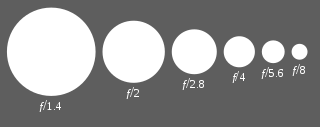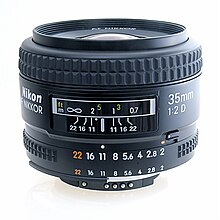
A | B | C | D | E | F | G | H | CH | I | J | K | L | M | N | O | P | Q | R | S | T | U | V | W | X | Y | Z | 0 | 1 | 2 | 3 | 4 | 5 | 6 | 7 | 8 | 9

An f-number is a measure of the light-gathering ability of an optical system such as a camera lens. It is calculated by dividing the system's focal length by the diameter of the entrance pupil ("clear aperture").[1][2][3] The f-number is also known as the focal ratio, f-ratio, or f-stop, and it is key in determining the depth of field, diffraction, and exposure of a photograph.[4] The f-number is dimensionless and is usually expressed using a lower-case hooked f with the format f/N, where N is the f-number.
The f-number is also known as the inverse relative aperture, because it is the inverse of the relative aperture, defined as the aperture diameter divided by focal length.[5] The relative aperture indicates how much light can pass through the lens at a given focal length. A lower f-number means a larger relative aperture and more light entering the system, while a higher f-number means a smaller relative aperture and less light entering the system. The f-number is related to the numerical aperture (NA) of the system, which measures the range of angles over which light can enter or exit the system. The numerical aperture takes into account the refractive index of the medium in which the system is working, while the f-number does not.
Notation
The f-number N is given by:
where is the focal length, and is the diameter of the entrance pupil (effective aperture). It is customary to write f-numbers preceded by "f/", which forms a mathematical expression of the entrance pupil's diameter in terms of and N.[1] For example, if a lens's focal length were 10 mm and its entrance pupil's diameter were 5 mm, the f-number would be 2. This would be expressed as "f/2" in a lens system. The aperture diameter would be equal to .
Most lenses have an adjustable diaphragm, which changes the size of the aperture stop and thus the entrance pupil size. This allows the user to vary the f-number as needed. The entrance pupil diameter is not necessarily equal to the aperture stop diameter, because of the magnifying effect of lens elements in front of the aperture.
Ignoring differences in light transmission efficiency, a lens with a greater f-number projects darker images. The brightness of the projected image (illuminance) relative to the brightness of the scene in the lens's field of view (luminance) decreases with the square of the f-number. A 100 mm focal length f/4 lens has an entrance pupil diameter of 25 mm. A 100 mm focal length f/2 lens has an entrance pupil diameter of 50 mm. Since the area is proportional to the square of the pupil diameter,[6] the amount of light admitted by the f/2 lens is four times that of the f/4 lens. To obtain the same photographic exposure, the exposure time must be reduced by a factor of four.
A 200 mm focal length f/4 lens has an entrance pupil diameter of 50 mm. The 200 mm lens's entrance pupil has four times the area of the 100 mm f/4 lens's entrance pupil, and thus collects four times as much light from each object in the lens's field of view. But compared to the 100 mm lens, the 200 mm lens projects an image of each object twice as high and twice as wide, covering four times the area, and so both lenses produce the same illuminance at the focal plane when imaging a scene of a given luminance.
A T-stop is an f-number adjusted to account for light transmission efficiency.
Stops, f-stop conventions, and exposure


The word stop is sometimes confusing due to its multiple meanings. A stop can be a physical object: an opaque part of an optical system that blocks certain rays. The aperture stop is the aperture setting that limits the brightness of the image by restricting the input pupil size, while a field stop is a stop intended to cut out light that would be outside the desired field of view and might cause flare or other problems if not stopped.
In photography, stops are also a unit used to quantify ratios of light or exposure, with each added stop meaning a factor of two, and each subtracted stop meaning a factor of one-half. The one-stop unit is also known as the EV (exposure value) unit. On a camera, the aperture setting is traditionally adjusted in discrete steps, known as f-stops. Each "stop" is marked with its corresponding f-number, and represents a halving of the light intensity from the previous stop. This corresponds to a decrease of the pupil and aperture diameters by a factor of 1/√2 or about 0.7071, and hence a halving of the area of the pupil.
Most modern lenses use a standard f-stop scale, which is an approximately geometric sequence of numbers that corresponds to the sequence of the powers of the square root of 2: f/1, f/1.4, f/2, f/2.8, f/4, f/5.6, f/8, f/11, f/16, f/22, f/32, f/45, f/64, f/90, f/128, etc. Each element in the sequence is one stop lower than the element to its left, and one stop higher than the element to its right. The values of the ratios are rounded off to these particular conventional numbers, to make them easier to remember and write down. The sequence above is obtained by approximating the following exact geometric sequence:
Photographers sometimes express other exposure ratios in terms of 'stops'. Ignoring the f-number markings, the f-stops make a logarithmic scale of exposure intensity. Given this interpretation, one can then think of taking a half-step along this scale, to make an exposure difference of "half a stop".
Fractional stops
Most twentieth-century cameras had a continuously variable aperture, using an iris diaphragm, with each full stop marked. Click-stopped aperture came into common use in the 1960s; the aperture scale usually had a click stop at every whole and half stop.
On modern cameras, especially when aperture is set on the camera body, f-number is often divided more finely than steps of one stop. Steps of one-third stop (1⁄3 EV) are the most common, since this matches the ISO system of film speeds. Half-stop steps are used on some cameras. Usually the full stops are marked, and the intermediate positions click but are not marked. As an example, the aperture that is one-third stop smaller than f/2.8 is f/3.2, two-thirds smaller is f/3.5, and one whole stop smaller is f/4. The next few f-stops in this sequence are:
To calculate the steps in a full stop (1 EV) one could use
The steps in a half stop (1⁄2 EV) series would be
The steps in a third stop (1⁄3 EV) series would be
As in the earlier DIN and ASA film-speed standards, the ISO speed is defined only in one-third stop increments, and shutter speeds of digital cameras are commonly on the same scale in reciprocal seconds. A portion of the ISO range is the sequence
Antropológia
Aplikované vedy
Bibliometria
Dejiny vedy
Encyklopédie
Filozofia vedy
Forenzné vedy
Humanitné vedy
Knižničná veda
Kryogenika
Kryptológia
Kulturológia
Literárna veda
Medzidisciplinárne oblasti
Metódy kvantitatívnej analýzy
Metavedy
Metodika
Text je dostupný za podmienok Creative
Commons Attribution/Share-Alike License 3.0 Unported; prípadne za ďalších
podmienok.
Podrobnejšie informácie nájdete na stránke Podmienky
použitia.
www.astronomia.sk | www.biologia.sk | www.botanika.sk | www.dejiny.sk | www.economy.sk | www.elektrotechnika.sk | www.estetika.sk | www.farmakologia.sk | www.filozofia.sk | Fyzika | www.futurologia.sk | www.genetika.sk | www.chemia.sk | www.lingvistika.sk | www.politologia.sk | www.psychologia.sk | www.sexuologia.sk | www.sociologia.sk | www.veda.sk I www.zoologia.sk











